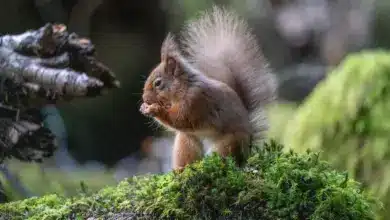Endangered and Extinct Bat Species – Humanity’s Impact
For many of us, bats are iconic creatures of the night. Movies, TV shows, and Halloween decorations often depict these animals as spooky, dangerous, or even evil.
However, in reality, bats are incredibly beneficial to both the environment and humans. In fact, bats are the only mammals capable of true flight.
However, as interesting as bats are, throughout the years, their populations have been in decline.
While there are still many bat species that are doing well, there are also several that are endangered or even extinct.
If you’re curious about which bat species are struggling and why, read on to learn more about endangered bat species and extinct bats.
Why Have Bats Become Endangered?
There are many reasons why bats have become endangered. Among the most common reasons are the use of insecticides, poison to protect wood structures, and habitat loss.
Below, we’ll take a more in-depth look at each of these reasons.
Insecticides
In many countries around Europe and the Americas, the Microchiroptera, being at the end of the entomological food chain, suffered horribly as a result of mankind’s chemical war with insects.
Many populations crashed during the 1960s when the use of DDT (dichlorodiphenyltrichloroethane) was widespread.
This insecticide not only killed the insects that bats ate, but it was also poisonous to the animal itself. Scientific research has shown that bats are more sensitive to DDT than either birds or other mammals.
The Mexican Free-tailed Bat, Tadarida brasiliensis, supplies a prime example. In 1937 the estimated mid-summer population of these bats in Carlsbad Carvern, New Mexico was 8.7 million, but by 1979 the estimated population was down to 218 thousand – or a mere 2.5 percent of what it was.
In addition, during a 1960s study of the bats of Eagle Creek Cave in Arizona, the mid-summer population was seen to drop from 25 million to only 30 thousand – or 0.12 percent of the original. This drastic decline was attributed to the use of DDT and other pesticides in agriculture.
Wood Preservatives
Poisoning also occurs when bats roost in man-made structures that have been treated with wood preservatives such as chromate copper arsenate (CCA). These chemicals can kill bats or make them too weak to fly, causing them to starve to death.
As we all know, bats love to roost in dark, secluded places such as the attics and crawl spaces of homes. Unfortunately, this means that they often come into contact with wood that has been treated with CCA.
The use of chlorinated hydrocarbons to protect wood from bats in both Europe and the USA has also had a detrimental effect on bat populations. In the USA, these pesticides were also used to specifically expel bats from roosts in houses.
According to the Encyclopedia of Mammals as edited by David Macdonald “In the United States fear of bats has been deliberately generated by the multi-million dollar pest control industry to attract business for the destruction of bats in buildings.”
As with all ecological problems, the two spines of the devil’s fork, ignorance and greed are largely to blame.
In more recent times, thanks to a lot of good work by a variety of conservationists and environmentalists, the use of such poisons have greatly declined – with synthetic pyrethroids and other similar chemicals taking their place. These chemicals are far less toxic to mammals.
Still, the damage to bat populations has been done and some species are now extinct as a result.
Habitat Loss
Poisons and persecution are of course not the only problem for endangered bats.
Habitat destruction, especially the loss of roosting and foraging sites, is also having a major impact.
The loss of old-growth forests has been especially hard on many bat species that rely on these ecosystems for both roosting and foraging.
As these forests are replaced by commercial timber plantations, the bats are left without the homes they need to survive.
In addition, the loss of wetlands has also been detrimental to bat populations. These habitats are important for a number of reasons, including providing the insects that bats feed on.
As development continues to encroach on natural habitats, it is likely that we will see more and more bat species added to the endangered list.
Other Contributors to Bat Population Declines
There are a number of other things that have had an impact on bat populations.
Other factors contributing to the extinction of certain bats are introduced species. In New Zealand, the spread of the introduced Polynesian Rat (Rattus exulans) and then the equally introduced Black Rat resulted in the decline and eventual extinction of Mystacina robusta (Rattus rattus).
Because these two species of rats prey on the same food source as Mystacina robusta they outcompeted the native bat for food, leading to its demise.
Other examples of introduced species damage include cats killing a large number of bats in the genus Chalinolobus in New Zealand and Australia, and juvenile Pteropus mariannus being eaten by the introduced tree-snake Boiga irregularis on Guam.
The Protection of Bats
The killing of bats for their meat and body parts is also a problem in some areas. Human consumption of bat meat is known to occur in Africa, Asia, the Pacific islands, and South America.
In all European countries, bats are now protected by law. In England, they are well protected by the law.
For instance, among other things, it is illegal to:
- Intentionally kill, injure or capture a bat
- Possess or control a live or dead bat, any part of a bat, or anything derived from a bat
- Intentionally or recklessly damage, destroy, or obstruct access to any place that a bat uses for shelter or protection.
The laws in Wales and Scotland are pretty much the same. The penalty for breaking these laws is £5,000 per bat. You even need a license to photograph bats in the UK. See UK Bat Law. Unfortunately, bats in other parts of the world are not so well protected.
Although two entire genera, Pteropus and Acerodon, are listed on Apendices 1 and 2 of CITES.
Extinct Bats
Despite the measures that have been put in place to protect them, a number of bat species have already become extinct
Nevertheless at least 12 species of bats have gone extinct in recent times.
| Scientific Name | Common Name | Date of Extinction | Authority (1) | Location |
|---|---|---|---|---|
| Acerodon lucifer | Panay Giant Fruit Back | 1892 | Elliot, 1896 | Panay Island, Philippines |
| Dobsonia chapmani | Philippine Bare-backed Fruit Bat | 1970 | Rabor, 1952 | Cebu and Negros Islands, Philippines |
| Mystacina robusta | New Zealand Greater Short-tailed Bat | 1960s | Dwyer, 1962 | Big South Cape Island, New Zealand |
| Nyctophilus howensis | Lord Howe Long-eared Bat | before 1500 | McKean, 1975 | Australia and New Caledonia |
| Nyctimene sanctacrucis | Nendo Tube-nosed Bat | 1907 | Troughton, 1931 | Solomon and Santa Cruz Islands |
| Phyllonycteris major | Puerto Rican Flower Bat | before 1500 | Anthony, 1917 | Puerto Rico |
| Pipistrellus sturdeei | Sturdee’s Pipistrelle | after 1915 | Thomas, 1915 | Bonin Islands |
| Pteropus brunneus | Dusky Flying Fox | after 1874 | Dobson, 1878 | Percy Island, Australia |
| Pteropus loochoensis | Okinawa Flying Fox | No Data | Gray, 1870 | Ryukyu Island, Japan |
| Pteropus pilosus | Large Palau Flying Fox | before 1874 | K. Andersen, 1908 | Palau |
| Pteropus subniger | Dark Flying Fox | 1860s | (Kerr, 1792) | Mauritius and Reunion Islands |
| Pteropus tokudae | Guam Flying Fox | 1968 | Tate, 1934 | Guam |
1 = The ‘Authority’ of a species is the name of the person who first described the species for science. The following date is the date of the description (if it is all in brackets it means the species has since been moved to a different genus)
Only three specimens of Pteropus tokudae were ever collected, the last being shot by hunters in 1968. Despite intensive fieldwork on the island’s fruit bats, no observations of the Guam Fruit Bat have been recorded since this time.
Below are two lists of both endangered and critically endangered bat species, both from the IUCN 2003 list. Don’t forget to check out the latest IUCN SSC Bat Specialist Group for the latest data for 2020.
Endangered Bats
| Scientific Name | Common Name |
|---|---|
| Acerodon jubatus | Golden Capped Fruit Bat |
| Balantiopteryx infusca | Ecuadorian Sac-winged Bat |
| Chalinolobus neocaledonicus | |
| Chiroderma improvisum | Guadeloupe Big-eyed Bat |
| Craseonycteris thonglongyai | Kitti’s Hog-nosed Bat |
| Dobsonia beauforti | Beaufort’s Naked-backed Fruit Bat |
| Emballonura semicaudata | Pacific Sheath-tailed Bat |
| Eptesicus guadeloupensis | Guadeloupe Big Brown Bat |
| Glischropus javanus | Javan Thick-thumbed Bat |
| Hesperoptenus doriae | False Serotine Bat |
| Hipposideros turpis | Lesser Great Leaf-nosed Bat |
| Laephotis namibensis | Namib Long-eared Bat |
| Leptonycteris nivalis | Mexican Long-nosed Bat |
| Miniopterus robustior | Loyalty Bent-winged Bat |
| Mormopterus phrudus | Incan Little Mastiff Bat |
| Murina grisea | Peter’s Tube-nosed Bat |
| Murina ussuriensis | Ussuri Tube-nosed Bat |
| Myonycteris brachycephala | Sao Tome* Collared Fruit Bat |
| Myotis findleyi | Findley’s Myotis |
| Myotis grisescens | Grey Myotis |
| Myotis milleri | Miller’s Myotis |
| Myotis ozensis | Honshu Myotis |
| Myotis pruinosus | Frosted Myotis |
| Myotis schaubi | Schaub’s Myotis |
| Myotis sodalis | Indiana Bat |
| Myotis stalkeri | Kei Myotis |
| Nyctophilus heran | Sunda Long-eared Bat |
| Phyllonycteris aphylla | Jamaican Flower Bat |
| Pipistrellus endoi | Endo’s Pipistrelle |
| Pteropus dasymallus | Ryukyu Fluing Fox |
| Pteropus leucopterus | White-winged Flying Fox |
| Pteropus mariannus | Marianna Flying Fox |
| Rhinolophus imaizumii | Imaizumi’s Horseshoe Bat |
| Rhinolophus keyensis | Insular Horseshoe Bat |
| Rhogeessa alleni | Allen’s Yellow Bat |
| Rhogeessa mira | Least Yellow Bat |
| Sturnira thomasi | Thomas’s Yellow-shouldered Bat |
Critically Endangered Bats
| Scientific Name | Common Name |
|---|---|
| Aproteles bulmerae | Bulmer’s Fruit Bat |
| Chaerephon gallagheri | Gallagher’s Free-tailed Bat |
| Coleura seychellensis | Seychelles Sheath-tailed Bat |
| Hipposideros nequam | Malayan Roundleaf Bat |
| Latidens salimalii | Salim Ali’s Fruit Bat |
| Mops niangarae | Niangara Free-tailed Bat |
| Murina tenebrosa | Gloomy Tube-nosed Bat |
| Myotis cobanensis | Guatemalan Myotis |
| Myotis planiceps | Flat-headed Myotis |
| Nyctimene rabori | Philippine Tube-nosed Bat |
| Otomops wroughtoni | Wroughton’s free-tailed Bat |
| Paracoelops megalotis | Vietnam Leaf-nosed Bat |
| Pharotis imogene | New Guinea Big-eared Bat |
| Pipistrellus anthonyi | Anthony’s Pipistrelle |
| Pipistrellus joffrei | Joffre’s Pipistrelle |
| Pteralopex acrodonta | Fijian Monkey-faced Bat |
| Pteralopex anceps | Bougainville Monkey-faced Bat |
| Pteralopex atrata | Cusp-toothed Flying fox |
| Pteralopex pulchra | Montane Monkey-faced Bat |
| Pteropus insularis | Chuuk Flying Fox |
| Pteropus livingstonii | Comoro Black Flying Fox |
| Pteropus molossinus | Caroline Flying Fox |
| Pteropus phaeocephalus | Mortlock Flying Fox |
| Pteropus pselaphon | Bonnin Flying Fox |
| Pteropus rodricensis | Rodrigues Flying Fox |
| Pteropus voeltzkowi | Pemba Flying Fox |
| Rhinolophus convexus | Bat |
| Scotophilus borbonicus | Lesser Yellow Bat |
| Taphozous troughtoni | Bat |





